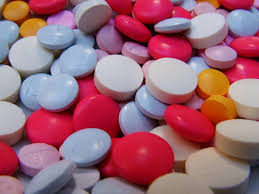Symptom Finder - Smooth Tongue and Other Changes
SMOOTH TONGUE AND OTHER CHANGES
There was a time when the first thing a physician did was to look at the tongue. The art of examining the tongue is all but lost, although more than 30 diseases can be diagnosed by looking at the tongue. Recalling these diseases may be best accomplished with the mnemonic VINDICATE. No attempt to cover all of them will be made, but the important ones are considered here.
V—Vascular diseases that may be diagnosed by looking at the tongue include the cyanosis of CHF, lung diseases, and polycythemia. The sublingual veins are also distended in these conditions.
I—Inflammatory diseases that cause tongue changes are streptococcal pharyngitis (strawberry tongue), tuberculosis (ulcers or furring of the tongue), chronic gastritis (coated gray), measles (furry tongue), appendicitis and peritonitis (moist and furry to dry and brown), typhoid (dense white fur), poliomyelitis (atrophy), syphilis (smooth or fissured tongue), herpes (ulcers), and moniliasis (white patches to white fur).
N—Neoplasms suggest carcinoma of the tongue (ulceration), leukoplakia (white plaques), diffuse lymphoma (small vesicles and a large tongue), fibroma (pediculated lesion on tongue), hemangioma (port-wine stain), and lingual warts.
D—Deficiency diseases include pernicious anemia (smooth tongue), iron deficiency anemia (smooth tongue), vitamin A deficiency, sprue, pellagra, and riboflavin deficiency (red and smooth tongue).
I—Intoxication suggests bromism (tremulous tongue with excessive salivation), alcoholism (tremulous, white furry tongue), mercury poisoning (ulcers), and lead poisoning (atrophy).
C—Congenital disorders include Down syndrome (large, coarsely papillate tongue), geographic tongue, and cerebral palsy.
A—Autoimmune diseases include amyloidosis (swollen tongue), erythema multiforme (swollen tongue with ulcers and blisters), angioneurotic edema, and multiple sclerosis (tremulous tongue with fibrillary twitching).
T—Trauma to the tongue is important to look for in cases of undiagnosed epilepsy.
E—Endocrine disorders include acromegaly (swollen tongue), myxedema (large tongue), lingual thyroid, and thyroglossal cysts.
Approach to the Diagnosis
The approach to the diagnosis will depend largely on the clinical picture. A smooth tongue with pallor of the nails and conjunctiva suggests pernicious anemia or iron deficiency anemia. A swollen tongue with cardiovascular abnormalities suggests amyloidosis. A swollen tongue and protruding jaw suggest acromegaly, whereas a swollen tongue and nonpitting edema prompt a diagnosis of myxedema. A dry, furry tongue suggests dehydration.
Other Useful Tests
1. CBC (pernicious anemia or iron deficiency anemia)
2. Serum B12 (pernicious anemia)
3. Serum iron and ferritin levels (iron deficiency anemia)
4. Thyroid profile (myxedema)
5. Antistreptolysin O (ASO) titer (strawberry tongue of streptococcal
infection)
6. Tongue biopsy (amyloidosis and focal lesions of the tongue)
There was a time when the first thing a physician did was to look at the tongue. The art of examining the tongue is all but lost, although more than 30 diseases can be diagnosed by looking at the tongue. Recalling these diseases may be best accomplished with the mnemonic VINDICATE. No attempt to cover all of them will be made, but the important ones are considered here.
V—Vascular diseases that may be diagnosed by looking at the tongue include the cyanosis of CHF, lung diseases, and polycythemia. The sublingual veins are also distended in these conditions.
I—Inflammatory diseases that cause tongue changes are streptococcal pharyngitis (strawberry tongue), tuberculosis (ulcers or furring of the tongue), chronic gastritis (coated gray), measles (furry tongue), appendicitis and peritonitis (moist and furry to dry and brown), typhoid (dense white fur), poliomyelitis (atrophy), syphilis (smooth or fissured tongue), herpes (ulcers), and moniliasis (white patches to white fur).
N—Neoplasms suggest carcinoma of the tongue (ulceration), leukoplakia (white plaques), diffuse lymphoma (small vesicles and a large tongue), fibroma (pediculated lesion on tongue), hemangioma (port-wine stain), and lingual warts.
D—Deficiency diseases include pernicious anemia (smooth tongue), iron deficiency anemia (smooth tongue), vitamin A deficiency, sprue, pellagra, and riboflavin deficiency (red and smooth tongue).
I—Intoxication suggests bromism (tremulous tongue with excessive salivation), alcoholism (tremulous, white furry tongue), mercury poisoning (ulcers), and lead poisoning (atrophy).
C—Congenital disorders include Down syndrome (large, coarsely papillate tongue), geographic tongue, and cerebral palsy.
A—Autoimmune diseases include amyloidosis (swollen tongue), erythema multiforme (swollen tongue with ulcers and blisters), angioneurotic edema, and multiple sclerosis (tremulous tongue with fibrillary twitching).
T—Trauma to the tongue is important to look for in cases of undiagnosed epilepsy.
E—Endocrine disorders include acromegaly (swollen tongue), myxedema (large tongue), lingual thyroid, and thyroglossal cysts.
Approach to the Diagnosis
The approach to the diagnosis will depend largely on the clinical picture. A smooth tongue with pallor of the nails and conjunctiva suggests pernicious anemia or iron deficiency anemia. A swollen tongue with cardiovascular abnormalities suggests amyloidosis. A swollen tongue and protruding jaw suggest acromegaly, whereas a swollen tongue and nonpitting edema prompt a diagnosis of myxedema. A dry, furry tongue suggests dehydration.
Other Useful Tests
1. CBC (pernicious anemia or iron deficiency anemia)
2. Serum B12 (pernicious anemia)
3. Serum iron and ferritin levels (iron deficiency anemia)
4. Thyroid profile (myxedema)
5. Antistreptolysin O (ASO) titer (strawberry tongue of streptococcal
infection)
6. Tongue biopsy (amyloidosis and focal lesions of the tongue)

